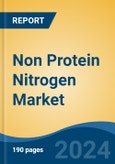Urea is the fastest growing segment, Asia-Pacific is the largest market globally
Speak directly to the analyst to clarify any post sales queries you may have.
10% Free customizationThis report comes with 10% free customization, enabling you to add data that meets your specific business needs.
Key Market Drivers
The global Non Protein Nitrogen market is significantly influenced by two fundamental drivers: the escalating worldwide demand for animal protein and the inherent cost-efficiency of non-protein nitrogen in animal feed formulations. The sustained growth in animal protein consumption, fueled by an expanding global population and evolving dietary preferences, places continuous pressure on livestock and aquaculture producers to enhance output. According to the United Nations' Food and Agriculture Organization (FAO), global meat production is forecast to reach 373 million tons in 2024, marking a 1.4% increase from 2023. This demand necessitates more efficient and economical animal nutrition strategies to maximize production from existing resources.Key Market Challenges
The potential for toxicity in livestock due to improperly dosed Non-Protein Nitrogen (NPN) compounds presents a significant challenge directly impeding the growth of the Global Non Protein Nitrogen Market. This inherent risk necessitates adherence to stringent regulatory frameworks and precise application protocols across agricultural operations. Such rigorous controls introduce substantial operational complexity for farmers, particularly within regions possessing developing agricultural infrastructure. This complexity can deter widespread adoption, as the burden of ensuring accurate dosage and complying with varied regulatory requirements may outweigh the perceived benefits of NPN utilization.Key Market Trends
The Global Non-Protein Nitrogen Market is significantly influenced by the development of targeted NPN formulations for specific livestock categories. This trend highlights the industry's progression towards precision nutrition, emphasizing customized NPN blends for particular animal species, age, or production stages. Such tailored formulations optimize NPN utilization, enhancing feed efficiency and mitigating risks associated with general dosing. This approach ensures ruminants receive optimal nitrogen balance for microbial protein synthesis, improving performance while reducing environmental impact. According to research published by UNH Today in August 2024, findings from a University of New Hampshire researcher indicated that feeding dairy cows specific amino acids enabled farmers to lower nitrogen concentrations in manure while maintaining milk production.Key Market Players Profiled:
- Altech Corp
- Kemin Industries Inc
- OCI Nitrogen BV
- Orica Ltd
- SABIC
- EuroChem Group AG
- Nutrien Ltd
- ADM Alliance Nutrition Inc
- CF Industries Holdings Inc
- Incitec Pivot Ltd
Report Scope:
In this report, the Global Non Protein Nitrogen Market has been segmented into the following categories:By Type:
- Urea
- Ammonia
- Biuret
- Others
By Livestock:
- Swine
- Poultry
- Dairy Cattle
- Others
By Region:
- North America
- Europe
- Asia Pacific
- South America
- Middle East & Africa
Competitive Landscape
Company Profiles: Detailed analysis of the major companies present in the Global Non Protein Nitrogen Market.Available Customizations:
With the given market data, the publisher offers customizations according to a company's specific needs. The following customization options are available for the report:- Detailed analysis and profiling of additional market players (up to five).
This product will be delivered within 1-3 business days.
Table of Contents
Companies Mentioned
- Altech Corp
- Kemin Industries Inc
- OCI Nitrogen BV
- Orica Ltd
- SABIC
- EuroChem Group AG
- Nutrien Ltd
- ADM Alliance Nutrition Inc
- CF Industries Holdings Inc
- Incitec Pivot Ltd
Table Information
| Report Attribute | Details |
|---|---|
| No. of Pages | 185 |
| Published | November 2025 |
| Forecast Period | 2024 - 2030 |
| Estimated Market Value ( USD | $ 1.55 Billion |
| Forecasted Market Value ( USD | $ 2.05 Billion |
| Compound Annual Growth Rate | 4.7% |
| Regions Covered | Global |
| No. of Companies Mentioned | 10 |









